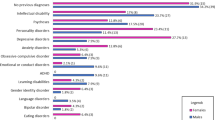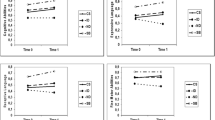Abstract
Objective
To assess diagnostic stability of initial autism spectrum disorder (ASD) diagnosed in children three years or less.
Methods
Participants in the study included 77 (64 boys,13 girls) children in whom a diagnosis of Autistic Disorder (AD) and Pervasive Developmental Disorder-Not Otherwise Specified (PDD-NOS) was made at age 3 years or less as per the DSM IV criteria. Children were recruited from the Outpatient services of the department of Pediatrics, Post Graduate Institute of Medical Education and Research, Chandigarh. Multi-disciplinary evaluations including neurological, diagnostic, cognitive, and behavioral assessments were made. In addition, the Childhood Autism Rating Scale (CARS) was administered to assess symptom severity. Follow up was done around 4 years of age.
Results
At Time 1, 64 (83.11%) children were diagnosed as AD and 13 (16.88%) children with PDD-NOS. Follow up was possible in only 43 children (55.8%) at the mean age of 4 years 1 month (SD = 0.99) after a mean age interval of 1.65 years (SD = 0.95). At Time 2, 37 (86%) children were diagnosed as AD and 4 (9.3%) children were diagnosed with PDD-NOS, and 2 (4.65%) children were found to be off the ASD spectrum. The diagnosis of ASD (AD and PDD-NOS) was stable over time and 41 (95.3%) out of 43 children retained an ASD diagnosis. Looking at specific ASD diagnosis, AD diagnosis was stable for 33 out of 37 (89.18%) children and the PDD-NOS was stable for only 1 out of 6 (16.67%) children.
Conclusions
An early and a stable diagnosis of ASD is possible provided there are expert clinicians available. Early detection and diagnosis of ASDs allows opportunities for children to profit more from early supports and interventions.

Similar content being viewed by others
References
American Psychiatric Association. Diagnostic and statistical manual of mental disorders. 4th ed. Washington: American Psychiatric Association; 1994.
Kogan MD, Blumberg SJ, Schieve LA, et al. Prevalence of parent-reported diagnosis of autism spectrum disorder among children in the US, 2007. Pediatrics. 2009;124:1–9.
Johnson CP, Myers SM, the Council on Children with Disabilities. Identification and evaluation of children with autism spectrum disorders. Pediatrics. 2007;120:1183–215.
Filipek PA, Accardo PJ, Ashwal S, et al. Practice parameter: Screening and diagnosis of autism: Report of the Quality Standards Subcommittee of the American Academy of Neurology and the Child Neurology Society. Neurology. 2000;55:468–79.
Zwaigenbaum L. Advances in the early detection of autism. Curr Opin Neurol. 2010;23:97–102.
Lord C. Follow-up of two-year-olds referred for possible autism. J Child Psychol Psychiatry. 1995;36:1365–82.
Stone W, Lee E, Ashford L, et al. Can autism be diagnosed accurately in children under 3 years? J Child Psychol Psychiatry. 1999;40:219–26.
Moore V, Goodson S. How well does early diagnosis of autism stand the test of time? Follow-up study of children assessed for autism at age 2 and development of an early diagnostic service. Autism. 2003;7:47–63.
Eaves L, Ho H. Brief report: Stability and change in cognitive and behavioral characteristics of autism through childhood. J Autism Dev Disord. 2004;26:557–69.
Kleinman J, Ventola P, Pandey J, et al. Diagnostic stability in very young children with autism spectrum disorders. J Autism Dev Disord. 2008;38:606–15.
Scambler DJ, Hepburn SL, Rogers SJ. A two-year follow-up on risk status identified by the checklist for autism in toddlers. J Dev Behav Pediatr. 2006;27:S104–10.
Alpern G, Boll T, Shearer M. Developmental Profile II (DP II). Los Angeles: Western Psychological Services; 1986.
Malin AJ. The Indian adaptation of the Vineland Social Maturity Scale. Lucknow: Indian Psychological Corporation; 1971.
Schopler E, Reichler R, Renner BR. The childhood autism rating scale. Los Angeles: Western Psychological Services; 1988.
Robins DL, Fein D, Barton ML, et al. The modified checklist for Autism in toddlers: an initial study investigating the early detection of autism and pervasive developmental disorders. J Autism Dev Disord. 2001;31:131–44.
Kumar N, Shekhar C, Kumar P, et al. Kuppuswamy socio-economic scale-updating for 2007. Indian J Pediatr. 2007;74:1131–2.
Sigman M, Ruskin E. Continuity and change in the social competence of children with autism, down syndrome, and developmental delays. Monogr Soc Res Child Dev. 1999;64:1–114.
Turner LM, Stone WL, Pozdol SL, et al. Follow-up of children with autism spectrum disorders from age 2 to age 9. Autism. 2006;10:243–65.
Matson J, Boisjoli J. Differential diagnosis of PDD-NOS in children. Res Autism Spectr Disord. 2007;1:75–84.
Tidmarsh L, Volkmar F. Diagnosis and epidemiology of autism spectrum disorders. Can J Psychiatry. 2003;48:517–25.
Volkmar F, Klin A, Siegel B, et al. Field trial for autistic disorder in DSM-IV. Am J Psychiatry. 1994;151:1361–7.
Helt M, Kelley E, Kinsbourne M, et al. Can children with autism recover? If so, how? Neuropsychol Rev. 2008;18:339–66.
Sutera S, Pandey J, Esser E, et al. Predictors of optimal outcome in toddlers diagnosed with autism spectrum disorders. J Autism Dev Disord. 2007;37:98–107.
DeGiacomo A, Fombonne E. Parental recognition of developmental abnormalities in autism. Eur Child Adolesc Psychiatry. 1998;7:131–6.
Conflict of Interest
None.
Role of Funding Source
None.
Author information
Authors and Affiliations
Corresponding author
Rights and permissions
About this article
Cite this article
Malhi, P., Singhi, P. Follow up of Children with Autism Spectrum Disorders: Stability and Change in Diagnosis. Indian J Pediatr 78, 941–945 (2011). https://doi.org/10.1007/s12098-011-0370-8
Received:
Accepted:
Published:
Issue Date:
DOI: https://doi.org/10.1007/s12098-011-0370-8




